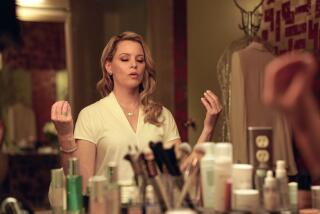Success Was Right at His Fingertips
- Share via
George Schaeffer didn’t know fake fingernails from real ones when he bought a dental supply company back in 1981. But he soon discovered that the acrylic material used to make dentures was a big seller with manicurists.
“They were buying hordes of it. They didn’t have the right products to make those acrylic nails--it was a very primitive industry--so they were coming to us.”
Sensing a business opportunity, Schaeffer hired a chemist, tinkered with his dental formula and within months was delivering packages of acrylic powder, liquid and primer to beauty salons throughout Los Angeles. Manicurists called it “the rubber-band special” because the ingredients and instruction sheet for making acrylic nails came wrapped in elastic.
From those rudimentary beginnings, Schaeffer has fashioned a nail-care business called OPI that posted more than $50 million in sales last year. That makes his North Hollywood company the biggest independent nail products manufacturer.
The growth of OPI from an obscure dental products firm (Schaeffer never bothered to change the name, which stands for Odontorium Products Inc.) to a nail-care company with 135 products mirrors the explosion in the nail industry nationwide.
Until the 1980s, manicures were widely considered a luxury and the manicurist herself was often relegated to a tiny counter inside a beauty salon, as epitomized by Madge, television’s pink-smocked manicurist.
No longer.
“Just like you get your hair cut every six weeks, you now get your nails done every 10 days. It’s become part of the ‘power’ look for women and an essential part of personal grooming,” says Vi Nelson, a spokeswoman for the Nail Manufacturers Council, a trade group in Chicago that is part of the larger American Beauty Assn.
Statistics tell the story. From 1991 to 1997, the number of nail salons in America nearly doubled from 26,752 to 45,163, says Nelson. During that same period, the number of licensed nail technicians exploded from 141,394 to 239,652. Today, nail care is a $6.5-billion industry, and that means big opportunity.
OPI’s biggest competitor, Vista, Calif.-based Creative Nail Design Inc. which was purchased three years ago by a unit of Revlon Inc., also came out of a dental products background. Both sell exclusively to salons via distributors. Firms such as Hard Candy and Urban Decay, by contrast, are strictly retail.
What the American nail-care industry shares, however, is a hub in Southern California. In addition to Creative Nail and OPI, there is Super Nail in Industry, Amoresse in Riverside, Jessica (located across the street from OPI), Orly in Chatsworth, Star Nail in Valencia, Hard Candy in Beverly Hills, Urban Decay in Costa Mesa and others. Indeed, even the industry’s two trade publications are based here: Nailpro in Van Nuys and Nails in Torrance.
*
Industry experts say that’s not surprising, because nails are part of the larger glamour industry so integral to Hollywood. OPI’s nail lacquers have been featured on TV shows such as the hip “Friends” and the movie “Boys on the Side” starring Drew Barrymore. Actor Ted Danson has promoted OPI products. And Schaeffer makes sure that a small cadre of nail technicians who do the nails of celebrities and actors are familiar with his products.
“There’s a certain amount of product placement,” says Kathy Kirkland, the executive editor of Nailpro.
But Kirkland adds that OPI wouldn’t succeed without a good product line. The firm is known industrywide for quality, a sophisticated training program and the larger-than-life persona of Schaeffer himself, who beats the OPI drum at every industry trade show.
“Nail technicians are a very tight group. They network like crazy and read all the trade publications. Everyone knows everyone,” says Kirkland.
A visit to the nearly 200,000-square-foot OPI complex, which sprawls across eight buildings in an industrial area, reveals a lot about its founder, an immigrant whose family fled Hungary in 1956 during the unsuccessful uprising against Communist domination.
He contributes heavily to charity--about $400,000 a year--and has proclamations from various civic and religious groups on his walls to prove it. An avowed patriot, he flies the American flag at his headquarters. Each doorway in the building is hung with a mezuzah, the Jewish talisman of blessing and luck.
Then there is the cafeteria, lined with 14 microwaves so the 225 employees at his headquarters don’t have to wait to heat up their lunches. (OPI has 50 more employees at facilities in West Palm Beach, Fla.; Chicago; Northern California; New Jersey; and a newly opened office in Guatemala.)
OPI’s four-employee laboratory, where new products are developed and tested, is staffed by scientists, including two with PhDs. One perk of working here is free manicures--the lab techs are constantly looking for guinea pigs on which to test new shades of nail polish, nail tips, odorless acrylics, lip liners and cuticle creams.
And 51-year-old Schaeffer is the biggest lab rat.
“I try everything,” he says. “I have to know if it works. For a month I wore lipstick. People thought I was weird, but I learned all about the taste and smell of women’s lipstick.”
In a way, Schaeffer’s immersion in the fashionable world of beauty-care products is a return to his origins. Soon after arriving in New York in 1956, Schaeffer’s parents bought three sewing machines and started to work in the rag business. By the time he reached his teens, the family business had 200 employees engaged in the manufacturing of low-end junior sportswear, a market segment Schaeffer calls “absolutely cutthroat.”
It was here that Schaeffer learned about costing, accounting, inventory and sales, skills he says have served him well with OPI. Schaeffer worked days and attended school at night, earning a bachelor’s degree in economics from City College of New York.
In 1981, as cheap imports began to flood the garment industry, he moved to Los Angeles with his young family and bought Davis Dental Supply Co. because he saw little future for himself in the family business.
Soon, manicurists were deluging him with requests. Then came a visit from health authorities who told him that dental acrylic was unsafe for nail use. It turned out that the same bonding used to hold dentures in place was so strong that women risked having their natural nails torn off if the long acrylic nails attached to them were to catch on something.
Within months, Schaeffer, who says he had no idea of the dangers, had found a chemist in a dental lab who had a side hobby creating movie make-up. Schaeffer offered him a 10% stake in the company to concoct a safer alternative for acrylic nails, then peddled the product door-to-door at salons.
*
The company boomed. In 1983, he added nail tips, and in 1984, polish in patented bottles with a weighted cap for more accurate application. (OPI holds 11 patents, more than double that of his nearest competitor.)
Three years ago Schaeffer rolled out a line of lipsticks and also his youth-oriented polish with wilder colors.
OPI also takes advantage of the fact that men now purchase 5% to 10% of all nail-care services. Nail Envy, a strengthener, and Matte Coat, a low-gloss finishing product, are popular with men who want groomed manicured hands without shiny nails.
Today, nail tips and acrylics account for 30% of OPI’s business, with the balance from polishes, creams and other salon retail products.
Meanwhile, OPI keeps expanding. Schaeffer is in escrow to buy two adjacent buildings and has his eye on a third. He sees potential growth in men’s products, spa treatment and pedicures--OPI is developing a line of products for the feet.
But with the domestic market tapping out, OPI is also looking abroad. Ninety percent of its sales are still in the U.S., with the balance coming mainly from Europe. But the Guatemala office is anticipating growing sales in South America.
And Schaeffer foresees expansion in Asia, especially Japan. “They’re really into lacquers,” he muses. “We could be huge.”
(BEGIN TEXT OF INFOBOX / INFOGRAPHIC)
Manicure Mania
Americans spend more on caring for their nails than they do on either movie tickets or lattes. Companies such as North Hollywood-based OPI are cashing in on the nation’s love affair with polished digits. How the nail industry’s receipts compare with U.S. sales of other leisure essentials:
Specialty coffee: $3.0 billion
Movie tickets: $6.4 billion
Nail care: $6.5 billion
Greeting cards: $7.5 billion
Pet accessories: $10 billion
Athletic shoes: $14.7 billion
*
Sources: Athletic Footwear Assn., Greeting Card Assn., Motion Picture Assn. of America, wire reports
Researched by JENNIFER OLDHAM / Los Angeles Times
More to Read
Inside the business of entertainment
The Wide Shot brings you news, analysis and insights on everything from streaming wars to production — and what it all means for the future.
You may occasionally receive promotional content from the Los Angeles Times.








